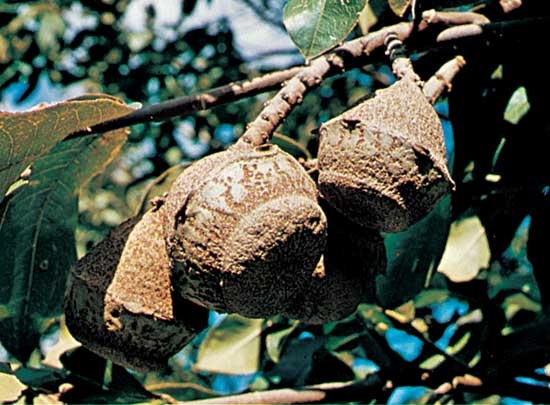Brazil nut
nut
also called Para nut, butternut, cream nut, or castanea
 edible seed of a large South American tree (Bertholletia excelsa) found in the Amazonian forests of Brazil, Peru, Colombia, and Ecuador. The Brazil nut is particularly well known in the Brazilian state of Pará, where it is called castanha-do-pará (Pará nut) and is grown as one of the major commercially traded nuts in the world. The tree itself grows wild in stands in the Amazon River basin, where it will often tower over its neighbours, reaching heights of 49 metres (160 feet) or more, with its crown spreading over 30 metres (100 feet) in diameter. The buttressed trunk is usually less than 2 metres (6.6 feet) across, but 3-metre (10-foot) specimens have been observed. Brazil nuts cannot, however, be cultivated in pure stands because of the tree's complex ecological requirements. (See rainforest ecosystem sidebar, “.”)
edible seed of a large South American tree (Bertholletia excelsa) found in the Amazonian forests of Brazil, Peru, Colombia, and Ecuador. The Brazil nut is particularly well known in the Brazilian state of Pará, where it is called castanha-do-pará (Pará nut) and is grown as one of the major commercially traded nuts in the world. The tree itself grows wild in stands in the Amazon River basin, where it will often tower over its neighbours, reaching heights of 49 metres (160 feet) or more, with its crown spreading over 30 metres (100 feet) in diameter. The buttressed trunk is usually less than 2 metres (6.6 feet) across, but 3-metre (10-foot) specimens have been observed. Brazil nuts cannot, however, be cultivated in pure stands because of the tree's complex ecological requirements. (See rainforest ecosystem sidebar, “.”)The hard-walled fruits of the tree are spherical pods, 8–18 cm (3–7 inches) in diameter, that resemble large coconuts hanging at the ends of the tree's thick branches. A typical 15-cm (6-inch) pod can weigh up to 2.7 kg (5 pounds), and a mature tree will produce more than 300 pods. From January to June the pods ripen and fall to the ground, where they can be harvested.
The woody pod contains 12–24 nuts, or seeds, that are arranged like the sections of an orange. The seeds are taken out, dried in the sun, then washed and exported while still in the shell. The brown shell is very hard and has three sides. High in fat and protein, the whitish meat tastes somewhat like almond or coconut and is so rich in oil that Brazil nuts will burn like a candle when lit.
The oil is often used in shampoos, soaps, hair conditioners, and skin care products. The sweet nuts are an important source of protein and calories for tribal, rural, and even urban Brazilians. Amazonians also use the empty pods as containers and brew the bark to treat liver ailments.
The Brazil nut tree belongs to the plant family Lecythidaceae, as do other tropical trees valued for their fruit and nuts (see cannonball tree, anchovy pear, and monkey pot).
- Kirszenstein-Szewińska, Irena
- Kiruna
- Kirwan, Richard
- Kiryū
- Kisangani
- Kisarazu
- Kiselyov, Pavel Dmitriyevich
- Kiselyovsk
- Ki Seto ware
- Kisfaludy, Károly
- Kish
- Kishangarh
- Kishangarh painting
- Kishi Nobusuke
- Kishiwada
- Kishorganj
- Kisi
- kiskadee
- Kiskunfélegyháza
- Kislovodsk
- Kismaayo
- kiss
- Kissidougou
- Kissimmee River
- Kissinger, Henry A.